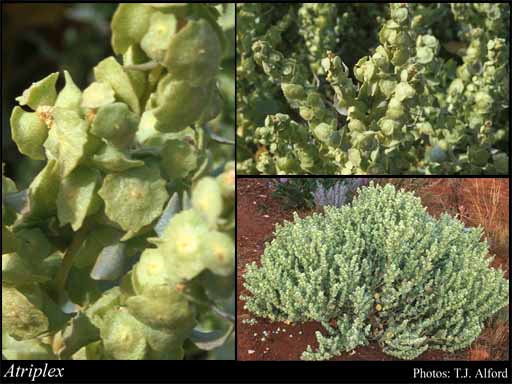- Reference
- Sp.Pl. [Linnaeus] 2:1052 (1753)
- Name Status
- Current







Scientific Description
Common name. Saltbushes. Family Chenopodiaceae.
Habit and leaf form. Shrubs, or herbs. Plants succulent, or non-succulent; unarmed. Annual, or perennial. Leaves cauline. Plants with a basal concentration of leaves, or with neither basal nor terminal concentrations of leaves. Stems not ‘jointed’. Stem internodes solid. Helophytic to xerophytic. Leaves minute to large; alternate (mostly), or opposite (lower leaves opposite or rarely opposite); spiral, or distichous; ‘herbaceous’; petiolate; simple; epulvinate. Leaf blades dissected, or entire; flat, or solid; sometimes semi-terete; linear to orbicular; pinnatifid, or palmately lobed; one-veined, or pinnately veined; cordate, or hastate, or sagittate, or attenuate at the base, or cuneate at the base. Leaves with stipules. Stipules concrescent. Leaf blade margins minute-toothed, lobed or hastate. Leaves without a persistent basal meristem. Leaf anatomy. Hydathodes present, or absent. Hairs present (indumentum of bladder-like hairs may collapse to form a scurfy or scaly covering then fuse to a silvery sheen). Extra-floral nectaries absent.
Reproductive type, pollination. Fertile flowers functionally male and functionally female, or functionally male, or functionally female. Unisexual flowers present. Plants monoecious, or dioecious. Female flowers without staminodes. Male flowers with pistillodes, or without pistillodes.
Inflorescence and flower features. Flowers solitary, or aggregated in ‘inflorescences’; in spikes, or in panicles, or in glomerules, or in fascicles (or clusters). The terminal inflorescence unit cymose. Inflorescences terminal, or axillary; male flowers usually confined to upper axils or to terminal arrangements often mixed with female flowers, male flowers in globular clusters in close or interrupted simple or paniculate spikes, or where axillary then each cluster usually surrounded by female flowers; female flowers rarely solitary. Flowers bracteate (B), or ebracteate (in male flowers); bracteolate (in female flowers a pair of bracteoles enlarge and cover fruit; bracteoles sessile or pedicellate, free or fused, entire or toothed, spongy or often inflated), or ebracteolate (in male flowers, rarely in female flowers); minute, or small; regular; cyclic. Free hypanthium present (slight), or absent. Hypogynous disk absent. Perianth sepaline, or vestigial to absent (absent from female flowers, except sometimes in A. hortensis); (3–)5; 1 -whorled; joined (imbricate); fleshy, or non-fleshy; persistent; accrescent, or non-accrescent. Calyx present, or absent (from female flowers, usually); absent from female flowers, being replaced by a pair of accrescent bracteoles which enlarge to cover the fruit; (3–)5; gamosepalous; deeply blunt-lobed; imbricate; of male flowers urceolate (nearly globular); non-fleshy; persistent (in the fruit). Calyx lobes obovate, or oblong (obtuse). Corolla absent. Fertile stamens present, or absent. Androecial members definite in number. Androecium 3–5. Androecial members free of the perianth, or adnate (to the base of the perianth); all equal; free of one another, or coherent; when coherent 1 - adelphous (connate at the base); 1 -whorled. Androecium exclusively of fertile stamens. Stamens 3–5; all more or less similar in shape; isomerous with the perianth; oppositisepalous. Anthers bent inwards in bud; dehiscing via longitudinal slits; tetrasporangiate. Fertile gynoecium present, or absent. Gynoecium (2–)5 carpelled. The pistil 1 celled. Gynoecium syncarpous; synovarious to synstylovarious; superior. Ovary unilocular; 1 locular; sessile. Gynoecium stylate. Styles 2; partially joined. Stigmas 2. Placentation basal. Ovules in the single cavity 1; pendulous, or ascending; non-arillate; campylotropous.
Fruit and seed features. Fruit non-fleshy; indehiscent; capsular-indehiscent (a utricle); 1 celled. Gynoecia of adjoining flowers combining to form a multiple fruit, or not forming a multiple fruit. Fruit 1 seeded. Seeds more or less non-endospermic. Perisperm present. Cotyledons 2. Embryo curved (annular).
Etymology. Name used by Pliny for orach or mountain spinach, A. hortensis or A. nitens.
Taxonomic Literature
- Cranfield, Raymond J. 2008. Atriplex eremitis (Chenopodiaceae), a new species for northern Western Australia.
- Wheeler, Judy; Marchant, Neville; Lewington, Margaret; Graham, Lorraine 2002. Flora of the south west, Bunbury, Augusta, Denmark. Volume 2, dicotyledons. Australian Biological Resources Study.. Canberra..
- Blackall, William E.; Grieve, Brian J. 1988. How to know Western Australian wildflowers : a key to the flora of the extratropical regions of Western Australia. Part I : Dicotyledons (Casuarinaceae to Chenopodiaceae). University of W.A. Press.. [Perth]..
- Australia. Bureau of Flora and Fauna 1984. Flora of Australia. Volume 4, Phytolaccaceae to Chenopodiaceae. Australian Govt. Pub. Service.. Canberra..